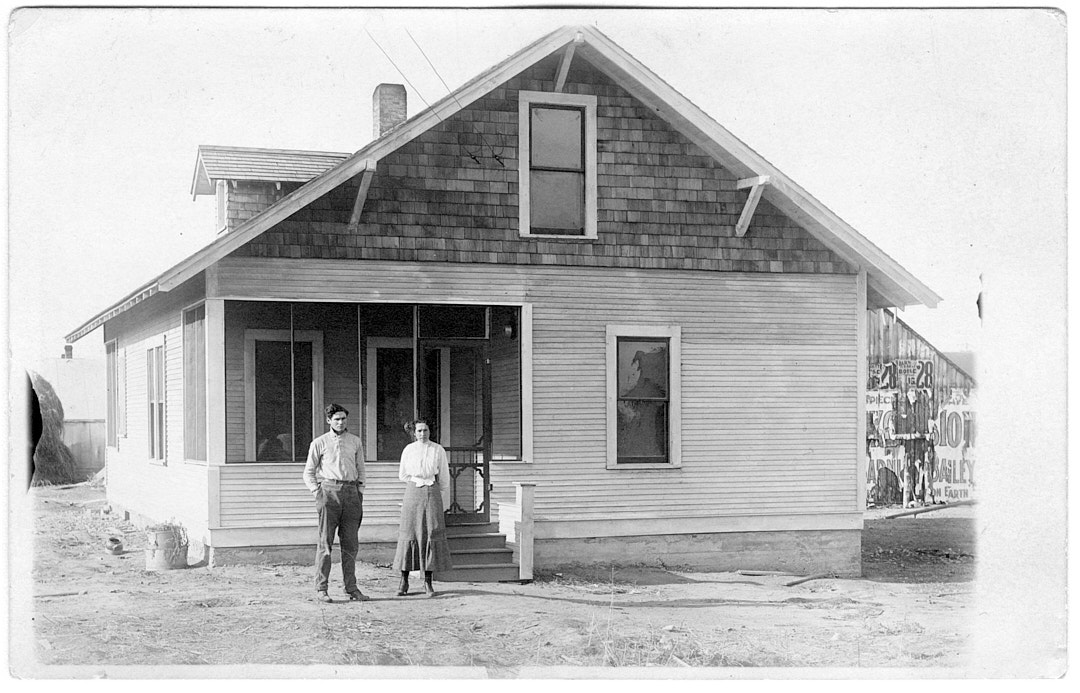Explore Collections
This collection includes photographs and diplomas documenting the early life of Marsh Nicholes, William Earl Hoalst, and their families in Ustick, Idaho. The images showcase agriculture, school groups, sports teams, and notable buildings in Ustick.
Marsh Nicholes was born on April 14, 1897, in Antimony, Utah, to Electa Elvira Webb and Josiah Edward Nicholes. She moved with her family to the Ustick townsite in Ada County between 1900 and 1910. After graduating from Ustick High School, she married William Earl Hoalst on November 10, 1917, and together they had five children. William Earl Hoalst was born on November 7, 1893, in Grouse, Idaho, to Ruth Permelia Taylor and Charles Rufus Hoalst. Earl attended Ustick High School along with his future wife. Marsh Nicholes Hoalst passed away on August 19, 1979, in Bruneau, Idaho, and W. Earl Hoalst died on July 23, 1972, in Glenns Ferry, Idaho.
The agricultural landscape of the Ustick townsite emerged from the irrigation infrastructure established by William Morris and later by his nephew, William Ridenbaugh, who financed the creation of the Ridenbaugh Canal system. Originally, the land that became Ustick was homesteaded by Jacob A. Clemens, who, like many others, was attracted to the area by advertisements for inexpensive, fertile farmland. Additionally, the 1890 electric streetcar system significantly contributed to the area's development by linking agricultural communities in the Boise Valley to the commercial centers of Boise, Caldwell, Nampa, and Meridian. Harlan Ustick, the town’s namesake, was a physician interested in horticulture, mining, banking, and transportation. Recognizing the potential of streetcar infrastructure, he invested in the Boise Rapid Transit Company.
On May 1, 1907, Dr. Harlan and Margaret Ustick submitted a plat for the Ustick townsite, located six miles west of Boise, covering eighty acres of farmland and a village plan featuring lots designated for a store and a blacksmith shop. The county road, Market Street (now Ustick Road), bordered the northern edge, while Settlers Canal and one of its laterals, North Slough, meandered through the northeast and southeast sections. The streetcar line ran north of the village along the southern right-of-way of Market Street. In June 1908, J.J. and Gertrude Shaw filed a plat for an additional eighty acres comprising thirty-two two-and-a-half-acre parcels north of the county road.
Aided by the nearby Boise Valley Railway streetcar line, Ustick rapidly expanded with land acquisitions and the establishment of key structures like Valley Store (later Ustick Mercantile), the First Bank of Ustick, Ustick Baptist Church (established in 1908), and Ustick School (opened in 1909). Plans also emerged for a livery stable, blacksmith shop, and lumber and coal yard within the village. Local farms and orchards benefited from a fruit packing plant and facilities for loading sugar beets onto streetcars for transportation to Nampa. Food processing ventures spawned by these surrounding farms included the Wood Vinegar Company, Ustick Cheese Factory, and the Manville Cider and Vinegar Works. In March 1908, Wilson H. Spangenberg became the first postmaster, running the post office from the general store. The community’s social and civic life thrived with the establishment of the Apple Blossom Club, a women’s organization aimed at civic improvement, on March 13, 1914.
Despite early progress, numerous blocks in the townsite remained undeveloped. The First Bank of Ustick shut down in 1911, and the streetcar line was discontinued in 1928 as automobile usage increased. The town was never formally incorporated, and by the close of World War II, many surrounding orchards had disappeared, giving way to housing developments. In February 1951, a fire destroyed the Ustick Baptist Church, and in 1959, Ustick School closed, replaced by Ustick Elementary School located nearly a mile to the west. The townsite's decline was solidified with the closure of the post office in 1978, followed by the general store.
Preservation Solutions LLC. (2019, September). Cultural Resource Survey Ustick Townsite Boise, Idaho.
Your search has also found results in related AM products.
Show me the resultsCopy the below link to share this set of search criteria with others. Using the link will allow others to see a list of search results on this site with the same parameters as those you've used.

